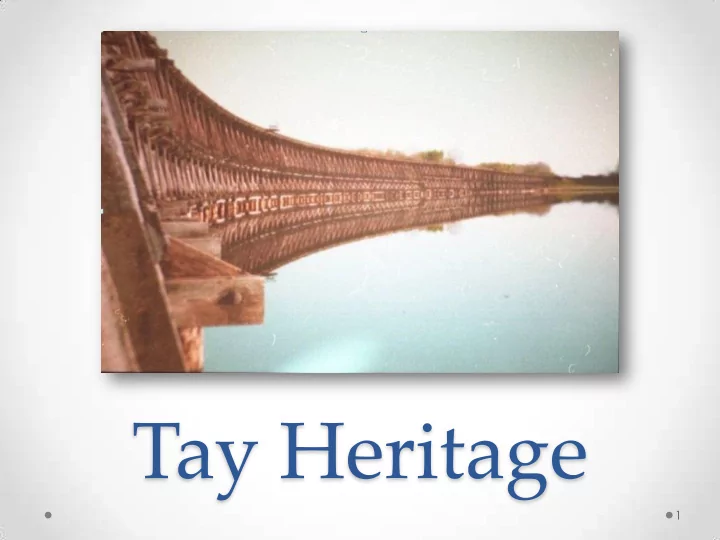

Tay Heritage 1
Contents • Importance of Heritage • The Heritage Act • Heritage Committee • Designation • After Designation • Easements • Conclusion 2
Importance of Heritage Heritage places are part of the identity and culture of a • community. They tell the story of its past and are something to take pride in. Preserving buildings and landscapes enhances the • character and diversity of a location. It allows residents to adapt and reuse instead of demolishing. “These places are integral parts of the identity of our • communities, but they also play a significant role in economic development by helping to enhance a community’s quality of life, strengthen its distinctiveness, stimulate revitalization and attract tourist dollars.” (Ministry of Culture and Recreation) 3
The Heritage Act • In Ontario, the Heritage Act is the most important piece of legislation for protecting our heritage resources. • It gives municipal governments the authority to: o Appoint a Heritage Committee o Designate properties of Cultural Heritage Value o Create a Heritage Register o Enter into Easement Agreements o Implement Tax Rebate Programs 4
Heritage Committee • Tay’s Heritage Committee is a seven member board that advises Council on heritage issues. • Members are appointed by council from the general public. The Mayor is also invited to be part of the Committee. • The main goal is to undertake research, prepare informational material and organize events to promote heritage (eg. Doors Open) • The Committee often partners with residents, community groups, and other heritage bodies such as the Huronia Museum 5
Heritage Designation • Municipal governments can designate a property of cultural heritage value or interest if it meets a set of prescribed criteria. • “Designation not only publicly recognizes and promotes awareness of heritage properties, it also provides a process for ensuring that changes to a heritage property are appropriately managed and that these changes respect the property’s heritage value. This includes protection from demolition.” (Ministry of Culture and Recreation) 6
Heritage Designation • All properties to be designated follow the same process: Identify as a candidate o • Submitted by committee, owner, or individual Research and Evaluate o • A report is prepared for Council by the Heritage Committee Notice of Intention to Designate o • A copy is sent to the property owner and posted in a local paper • A period of time is allotted to file an objection Council passes By-law o • The By-law is registered on the title of the property Once designated, the property is listed on the Municipal and Provincial o Registers 7
Heritage Designation • Many types of sites can be designated as having cultural heritage value or interest such as buildings, monuments, natural features, cemeteries, spiritual sites, building interiors, ruins, and archaeological sites. • Properties are evaluated on four major criteria: Community Context o Historical Research o Site Analysis and Physical Evidence o Context and Environment o • Once the evaluation is completed, a report is prepared and submitted to council for review 8
After Designation • Demolition and Alteration Any works involving a heritage aspect require a Heritage Permit. These are o reviewed by the Heritage Committee and a recommendation is given to Council. The Committee can also act as a resource for the property owner and give suggestions on alterations. Demolition requires 60 days written notice to give Council time to consider o the notice and take any appropriate action. If an application for alteration is o refused or the owner objects to the terms, they may appeal to the Conservation Review Board. The Board’s findings are considered by Council and a final decision is made. 9
After Designation • Change in Ownership After a change in ownership, the new owner is required to give notice to o the clerk within 30 days. Heritage designations and easements are registered on the title of the o property and are transferred to the new owner. • Maintenance Standards Council has the authority to o pass a Building By-law that sets out minimum maintenance standards for protecting the heritage attributes of the property. 10
After Designation • Tax Rebates The owner of a designated property with a heritage easement can obtain o a property tax rebate. Up to 40% of the building that is eligible heritage property and up to 10% o of the land used in connection with that heritage property. • Amendment and Repeal Council has the power to amend or repeal a designation By-law. o This follows a similar process and notice period as the initial designation. o 11
After Designation • Offences and Restoration If a building is altered against the Act, Council may restore the property to o its original condition and recover costs from the owner. Council can also give authority to anyone who must enter the property for o the restoration. These powers do not apply if the property is altered for reasons of public o health and safety or for the preservation of the property. 12
Heritage Easements • Another way in which a property can be recognized for having cultural heritage value is through a heritage easement. • This is a covenant between the municipality and property owner that can apply to any property. • It allows the municipality and property owner to work together to ensure the property’s protection. • A grant or loan may be given to the owner as part of the easement agreement. There may also be tax benefits. 13
Conclusion • The importance of preserving our heritage cannot be understated. We all have a part to play in promoting Tay Township’s history. • “If Ontario’s heritage is to be preserved, it will be because of local initiative and involvement.” (Ministry of Culture and Recreation) • If you have any questions or would like more information on heritage, visit our website at www.tay.ca, or contact us at 705-534-7248. 14
Recommend
More recommend